key OLDSMOBILE BRAVADA 1998 User Guide
[x] Cancel search | Manufacturer: OLDSMOBILE, Model Year: 1998, Model line: BRAVADA, Model: OLDSMOBILE BRAVADA 1998Pages: 380, PDF Size: 19.2 MB
Page 73 of 380

Liftgate
It can be dangerous to drive with the rear
window or liftgate open because carbon
monoxide (CO) gas can come into your vehicle.
You can’t see or snlell CO. It can cause
unconsciousness and even death.
If you must drive with the rear window or liftgate
open or if electrical wiring or other cable
connections must pass through the seal between
the body and the rear window or liftgate:
0 Make sure all windows are shut.
0 Turn the fan on your heating or coaling
system to its highest speed with the setting
on
VENT. That will force outside air into
your vehicle. See “Comfort Controls” in
the Index.
instrument panel, open them all the
way.
If you have air outlets on or under the
See “Engine Exhaust” in the Index.
Liftgate Release
There are several ways to release the liftgate. However,
the liftgate
will not release if the vehicle is in gear.
You can use your key
to unlock the liftgate from the
outside. Insert the key into
the liftgate lock button and
turn
it to the left. All doors will unlock.
You may
also use the Keyless Entry System
described earlier.
The liftgate can be opened without
a key if the driver’s
door
is unlocked.
To open the liftgate glass
only, ~~nlock the liftgate
and press the button.
To open the entire liftgate, unlock the liftgate and lift the
handle located
in the center of the door.
2-9
ProCarManuals.com
Page 74 of 380
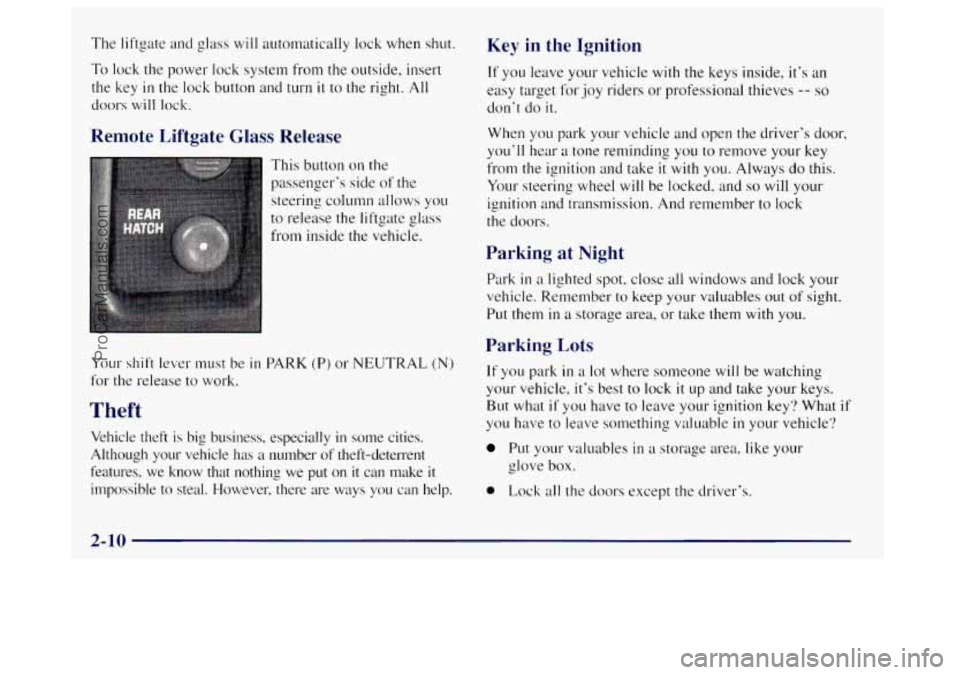
The liftgate and glass will automatically lock when shut.
To
lock the power lock system from the outside, insert
the key
in the lock button and turn it to the right. All
doors will lock.
Remote Liftgate Glass Release
This button on the
passenger’s side
of the
steering column allows you
to release the liftgate glass
from inside
the vehicle.
Key in the Ignition
If you leave your vehicle with the keys inside, it’s an
easy target for joy riders or professional thieves
-- so
don’t do it.
When you park your vehicle and open the driver’s door,
you’ll hear
a tone reminding you to remove your key
from the ignition
and take it with you. Always do this.
Your steering wheel
will be locked, and so will your
ignition and transmission. And remember to lock
the doors.
Parking at Night
Park in a lighted spot, close all windows and lock your
vehicle. Remember
to keep your valuables out of sight.
Put
them in a storage area, or take them with you.
Your shift lever must be
in PARK (P) or NEUTRAL (N)
for the release to work.
Theft
Vehicle theft is big business, especially in some cities.
Although your vehicle
has a number of theft-deterrent
features, we know that nothing we put
on it can make it
impossible to steal. However, there are ways you can help.
Parking Lots
If you park in a lot where someone will be watching
your vehicle, it’s best to lock
it up and take your keys.
But what
if you have to leave your ignition key‘? What if
you have to leave something valuable in your vehicle?
Put your valuables in a storage area, like your
glove box.
0 Lock all the doors except the driver’s.
2-10
ProCarManuals.com
Page 75 of 380
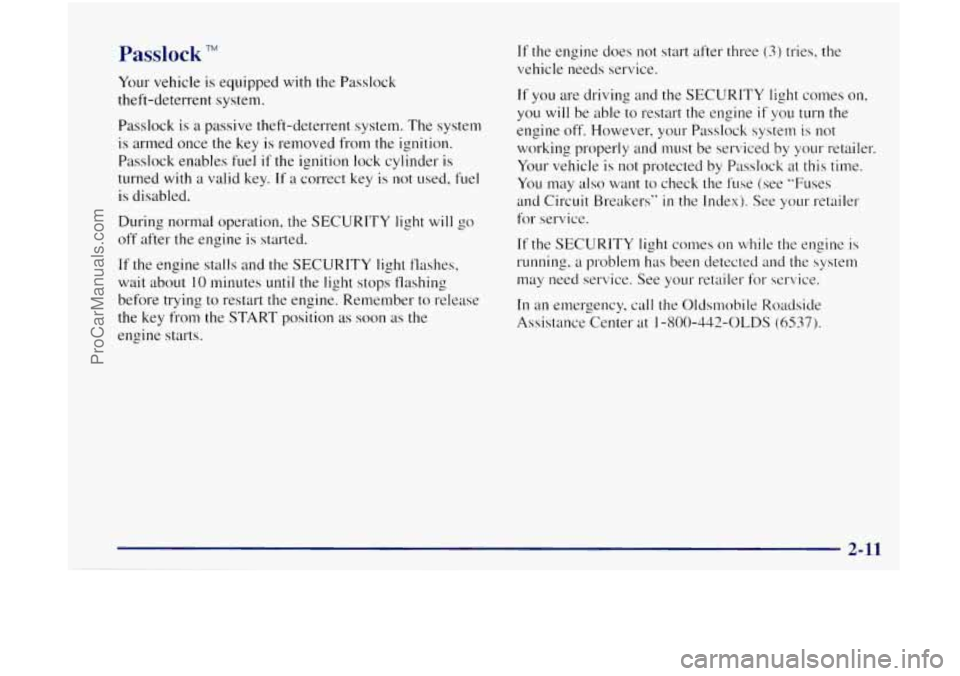
Passlock TM
Your vehicle is equipped with the Passlock
theft-deterrent system.
Passlock
is a passive theft-deterrent system. The system
is armed once the
key is removed from the ignition.
Passlock enables fuel if the ignition lock cylinder
is
turned with a valid key. If a correct key is not used, fuel
is disabled.
During normal operation, the SECURITY light will go
off after the engine is started.
If the engine stalls and the SECURITY light flashes,
wait about
10 minutes until the light stops flashing
before trying to restart the engine. Remember to release
the key from the START position
as soon as the
engine starts.
If the engine does not start after three (3) tries, the
vehicle needs service.
If you are driving and the SECURITY light comes on,
you will be able to restart the engine if you turn the
engine off. However, your Passlock system is not
working properly and must be serviced by your retailer.
Your vehicle is not protected by Passlock at this time.
You may
also want to check the fuse (see “Fuses
and Circuit Breakers” in the Index). See your retailer
for service.
If the SECURITY light comes on while the engine is
running, a problem has been detected and the system
may need service. See your retailer for service.
In an emergency, call the Oldsmobile Roadside
Assistance Center at
1 -800-442-OLDS (6537).
ProCarManuals.com
Page 76 of 380
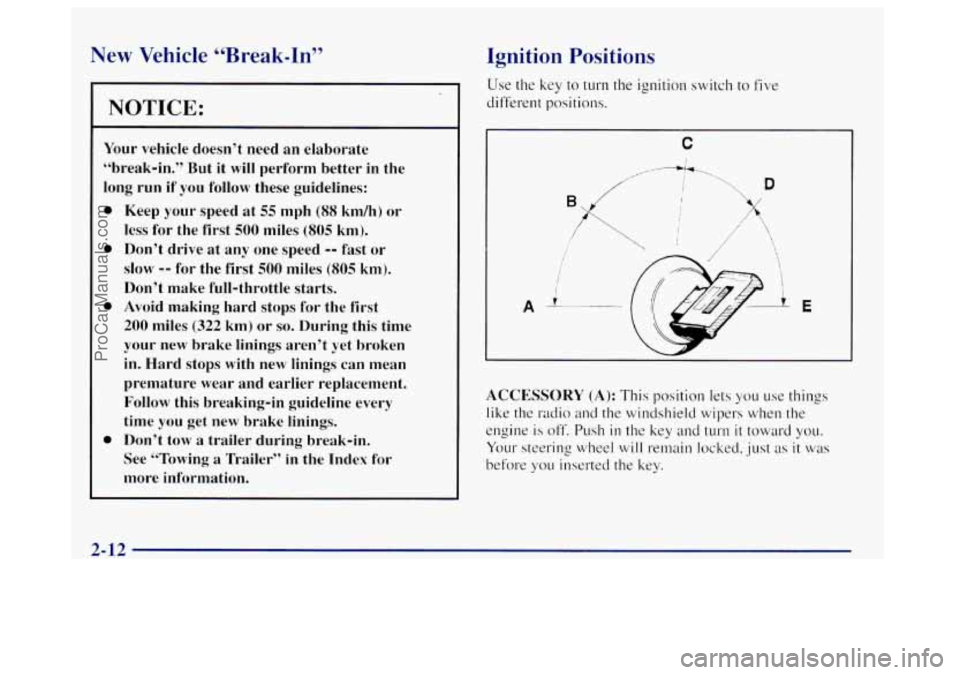
New Vehicle “Break-In”
NOTICE:
Your vehicle doesn’t need an elaborate
“break-in.” But it
will perform better in the
long run if you follow these guidelines:
a
0
a
0
Keep your speed at 55 mph (88 knlhj or
less for the first
500 miles (805 kmj.
Don’t drive at any
one speed -- fast or
slow
-- for the first 500 miles (805 km).
Don’t make full-throttle starts.
Avoid making hard stops for the first
200 miles (322 km) or so. During this time
your new brake linings aren’t yet broken
in. Hard stops with new linings can mean
premature wear and earlier replacement. Follow this breaking-in guideline every
time you get new brake linings.
Don’t tow
a trailer during break-in.
See “Towing a Trailer” in the Index for
more information.
Ignition Positions
Use the key to turn the ignition switch to five
different positions.
C
E
ACCESSORY (A): This position lets you use things
like the radio and
the windshield wipers when the
engine is off. Push in the key and turn it toward you.
Your steering wheel will remain locked, just
as it was
before
yo~l inserted the key.
2-12
- . -~
ProCarManuals.com
Page 77 of 380
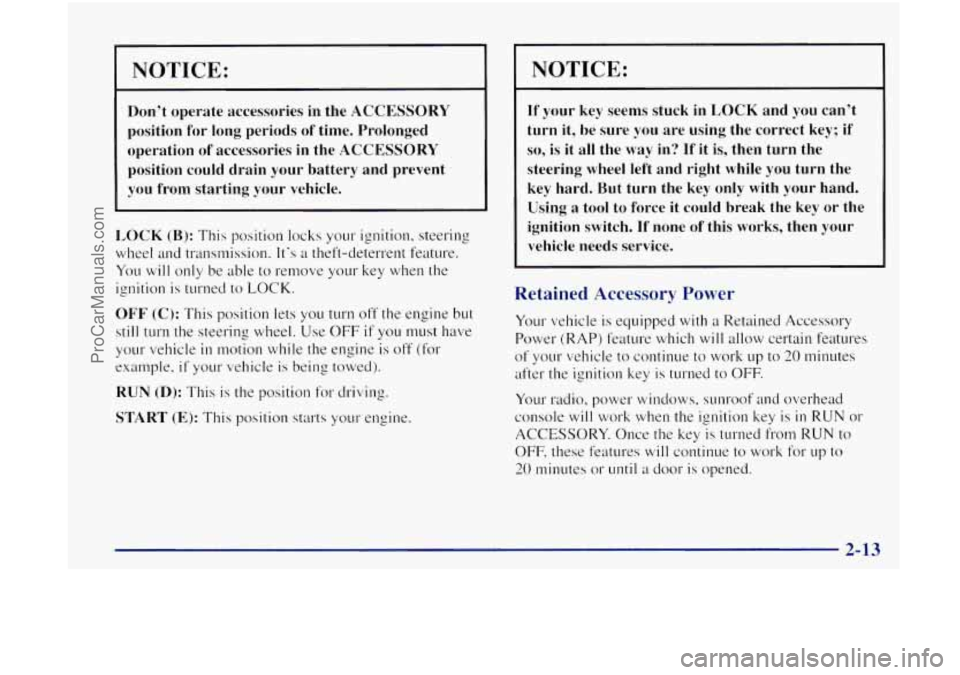
NOTICE:
Don’t operate accessories in the ACCESSORY
position for long periods of time. Prolonged
operation of accessories in the
ACCESSORY
position could drain your battery and prevent
you from starting your vehicle.
LOCK (B): This position locks your ignition, steering
wheel and transmission. It’s
a theft-deterrent feature.
You will only be able to remove your key when the
ignition is turned to
LOCK.
OFF (C): This position lets you turn off the engine but
still turn the steering wheel. Use
OFF if you must have
your vehicle
in motion while the engine is off (for
example,
if your vehicle is being towed).
RUN (D): This is the position for driving.
START (E): This position starts your engine.
NOTICE:
If your key seems stuck in LOCK and you can’t
turn it, be sure you are using the correct key; if
so, is it all the way in? If it is, then turn the
steering wheel left and right while you turn the
key hard. But turn the key only with your hand.
Using
a tool to force it could break the key or the
ignition switch.
If none of this works, then your
vehicle needs service.
Retained Accessory Power
Your vehicle is equipped with a Retained Accessory
Power (RAP) feature which will allow certain features
of your vehicle to continue to work up to 20 minutes
after the ignition
key is turned to OFF.
Your radio, power windows, sunroof and overhead
console
will work when the ignition key is in RUN or
ACCESSORY. Once the key is turned from
RUN to
OFF, these ,features will continue to work for up to
20 minutes or until a door is opened.
ProCarManuals.com
Page 78 of 380

Starting Your Engine
Move your shift lever to PARK (P) or NEUTRAL (N).
Your engine won’t start in any other position -- that‘s a
safety feature. To restart when you’re already moving,
use NEUTRAL
(N) only.
NOTICE:
Don’t try to shift to PARK (P) if your vehicle is
moving. If you do, you could damage the
transmission. Shift to PARK
(P) only when your
vehicle is stopped.
1. Without pushing the accelerator pedal. turn your
ignition key to START. When the engine starts. let
engine gets warm.
2 *o of the key. The idle speed will go down as your
NOTICE:
Holding your key in START for longer than 15
seconds at a time will cause your battery to be
drained much sooner. And the excessive heat can
damage your starter motor.
2. If it doesn’t start right away, hold your key in
START. If it doesn’t start in 10 seconds, push the
accelerator pedal all the way down for five more
seconds, or
until it starts.
3. If your engine still won’t start (or starts but then
stops), wait
15 seconds and start over.
When the engine starts, let
go of the key and the
accelerator pedal.
NOTICE:
Your engine is designed to work with the
electronics
in your vehicle. If you add electrical
parts or accessories, you could change the
way
the engine operates. Before adding electrical
equipment, check with your retailer. If you don’t,
your engine might not perform properly.
If you ever have to have your vehicle towed, see
the part of’this manual that tells how to
do it
without damaging your vehicle. See “Towing
Your Vehicle” in the Index.
2-14
ProCarManuals.com
Page 81 of 380

EIISLW the shift lever is f~~lly in PARK (P) range
before starting the engine. Your vehicle has
a
Brake-Transmission Shift Interlock (BTSI). You
have to fully apply your regular brakes before you can
shift from PARK
(P) when the ignition key is in RUN.
If you cannot shift out of PARK (P), ease pressure on
the shift lever -- press the button on the shift lever and
push the shift lever
all the way into PARK (P) as you
maintain brake application. Then move the shift lever
into the gear you wish. See ”Shifting Out of PARK (P)”
in the Index.
REVERSE (R): Use this gear to back up.
NOTICE:
Shifting to REVERSE (R) while your vehicle is
moving forward could damage your
transmission. Shift
to REVERSE (R) only after
your vehicle
is stopped.
To rock your vehicle back and forth to get out of snow,
ice or sand without damaging your transmission, see
”Stuck:
In Sand, Mud, Ice or Snow’‘ in the Index.
NEUTRAL (N): In this position, your engine doesn’t
connect
with the wheels. To restart when you’re already
moving, use NEUTRAL (N) only.
Shifting out
of PARK (P) or NEUTRAL (N) while
your engine
is “racing” (running at high speed) is
dangerous. Unless your foot
is firmly on the
brake pedal, your vehicle could move very
rapidly. You could lose control and hit people or
objects. Don’t shift out of
PARK (P) or
NEUTRAL (N) while your engine is racing.
I NOTICE:
Damage to your transmission caused by shifting
out of
PARK (P) or NEUTRAL (N) with the
engine racing isn’t covered by your warranty.
ProCarManuals.com
Page 84 of 380

Shifting Into PARK (P)
c
It can be dangerous to get out of your vehicle if’
the shift lever is not fully in PARK (P) with the
parking brake firmly set. Your vehicle can roll.
If
you have left the engine running, the vehicle can
move suddenly. You or others could be injured.
To be sure your vehicle won’t move, even when
you’re on fairly level ground, use the steps that
follow. If you’re pulling a trailer, see “Towing a
Trailer” in the Index.
1. Hold the brake pedal down with your right foot and
set the parking brake.
!. Move the shift lever into PARK (P) position like this:
P
a
Hold in the button on the lever.
Push the lever all the way toward the front of
the vehicle.
3. Turn the ignition key to LOCK.
4. Remove the key and t,&e it with you. If you can leave
your vehicle
with the key, your vehicle is in PARK (P).
2-20
ProCarManuals.com
Page 86 of 380
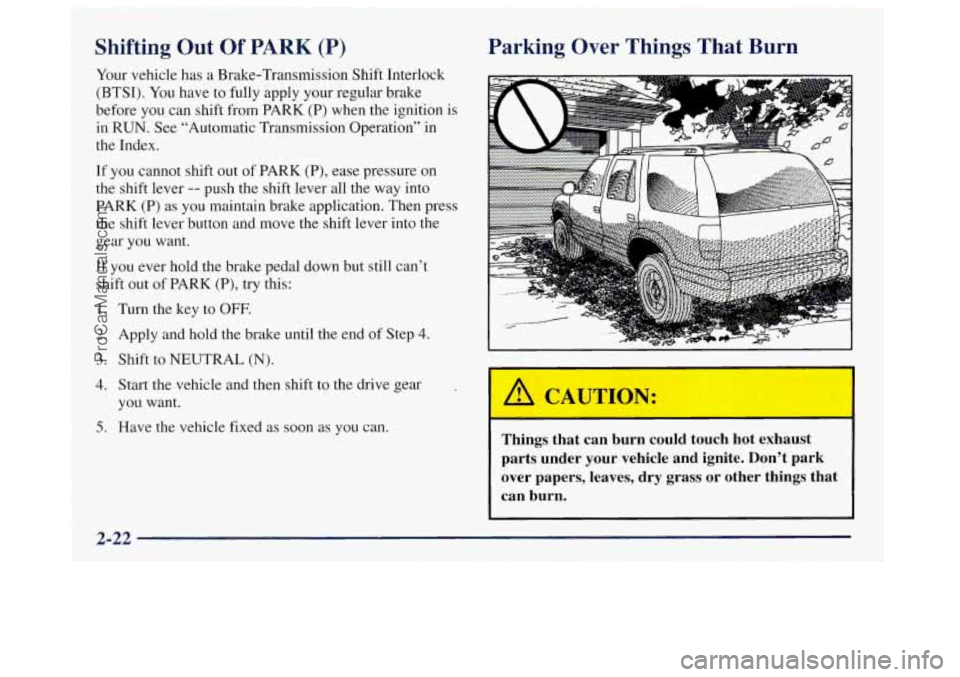
Shifting Out Of PARK (P)
Your vehicle has a Brake-Transmission Shift Interlock
(BTSI).
You have to fully apply your regular brake
before
you can shift from PARK (P) when the ignition is
in
RUN. See “Automatic Transmission Operation” in
the Index.
If you cannot shift out of PARK
(P), ease pressure on
the shift lever
-- push the shift lever all the way into
PARK
(P) as you maintain brake application. Then press
the shift lever button and move the shift lever into the
gear you want.
If you ever hold the brake pedal down but still can’t
shift
out of PARK (P), try this:
1. Turn the key to OFF.
2. Apply and hold the brake until the end of Step 4.
3. Shift to NEUTRAL (N).
4. Start the vehicle and then shift to the drive gear
you want.
5. Have the vehicle fixed as soon as you can.
Parking Over Things That Burn
I I
Things that can burn could touch hot exhaust
parts under your vehicle and ignite. Don’t park
over papers, leaves, dry grass or other things that
can burn.
2-22
ProCarManuals.com
Page 97 of 380

To idle your vehicle with the automatic headlamp
system off, set the parking brake while the ignition is
off. Then start your vehicle. The automatic headlamp
system
will stay off until you release the parking brake.
As with any vehicle, you should turn on the regular
headlamp system when you need
it.
Lamps On Reminder
A reminder tone will sound when your headlamps or
parking lamps are manually turned on and your ignition
is
in OFF, LOCK or ACCESSORY. To turn the tone off, turn
the knob all the way to the left.
In the automatic mode, the
headlamps
turn off once the ignition key is in OF.
Daytime Running Lamps
Daytime Running Lamps (DRL) can make it easier for
others to see the front of your vehicle during the day.
DRL can be helpful in many different driving
conditions, but they can be especially helpful
in the
short periods after dawn and before sunset.
The DRL system will
make your headlamps come on at
reduced brightness when:
the ignition is on,
the headlamp switch is in automatic headlamp mode and
0 the parking brake is released. When the
DRL are on, only your headlamps will be on.
The taillamps, sidemarker and other lamps won't be on.
The instrument panel won't be
lit up either.
When
it begins to get dark, the headlamps will
automatically switch from DRL
to the regular headlamps.
When you turn the headlamp switch off, the regular lamps
will go off, and your headlamps will change to the reduced
brightness of DRL provided
it is not dark outside.
To idle your vehicle with the DRL off, set the parking
brake. The DRL will stay off
until you release the
parking brake.
As with any vehicle. you should turn on the regular
headlamp system
when you need it.
Fog Lamps
Use your fog lamps for better vision in foggy or misty
conditions. Your low-beam headlamps must be
on for
your fog lamps to work.
The fog lamp switch is
on the instrument panel under
the lamps switch. Press the switch to turn the fog lamps
on. Press the switch again to turn them off.
A light will
glow
in the switch when the fog lamps are on.
Fog lamps will go off whenever your high-beam
headlamps come on. When the high beams go off, the
fog lamps
will come on again.
ProCarManuals.com